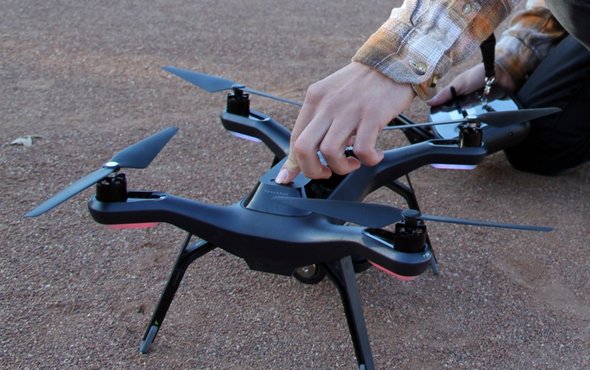(单词翻译:单击)
听力文本
This is Scientific American — 60-Second Science. I'm Karen Hopkin.
Ecologists crouching quietly amidst vegetation, using binoculars to tally birds in a roost, may soon be a charming relic of the past. Because a new study shows that, when it comes to getting an accurate avian head count, aerial drones can do better.
In recent years, scientists who study wild populations are increasingly turning to remotely piloted aircraft...otherwise known as drones...to monitor their animal of interest. For example, drones are being used to track pods of whales...or to keep an eye on African elephant herds and watch for signs of poaching.
Such remote surveys are generally considered highly cost-effective. But it wasn't clear whether they are as accurate as old-fashioned, feet-on-the-ground, expert evaluations.
To find out, researchers in Australia set up a test.
"And so what we did was make some replica seabird colonies where we knew the true number of individuals in each colony."
Jarrod Hodgson of the University of Adelaide led the study.
Using decoy-sized rubber ducks, the researchers laid out 10 colonies...ranging in size from about 500 to more than 1,000 individuals.
"We then had experienced ground counters make independent counts of those birds from nearby, from the optimum vantage point. At the same time, we flew a drone overhead capturing photographs at different heights above the colony."

The drone data were then analyzed two ways. First, a gaggle of citizen–scientists was tasked with adding up the number of birds they could see in each scene.
The results of that approach:
"We found that on average the drone-derived data or the drone-derived counts made by humans counting the images were between 43 percent and 96 percent more accurate than the traditional ground-based counts."
The better the image, the more accurate the count.
Then, Hodgson and his team developed a semi-automated computer program to do the counting for them. And they found:
"...there was no statistical difference between those counts and the counts completed by our volunteers using exactly the same imagery."
The results appear in the journal Methods in Ecology and Evolution.
So counting by drone not only saves time and effort, but yields better data...a definite plus in terms of conservation.
"When we monitor wildlife, increasing the accuracy and the precision of animal surveys gives us more confidence in our population estimates. And this means that we have a stronger evidence base on which to make management decisions or policy changes."
In other words, a drone in the sky is better than two PhDs in the bush. Who can rely on better data to be feathers in their caps.
Thanks for listening for Scientific American — 60-Second Science. I'm Karen Hopkin.
参考译文
这里是科学美国人——60秒科学。我是克里斯托弗·因塔利亚塔。
生态学家安静地蹲伏在植被中间,用双筒望远镜观察并记录栖息地中的鸟类数量,这种方法可能很快就会成为迷人的“老古董”。因为一项新研究表明,在获得鸟类的准确数量方面,空中无人机可以做得更好。
近年来,研究野生种群的科学家逐渐使用遥控飞机,即无人机,来监测他们感兴趣的动物。例如,无人机现在被用来追踪鲸群,或观察非洲象群并密切注意偷猎迹象。
这种远程调查通常被认为具有很高的性价比。但是并不清楚这种方法是否像老式的实地专家评估那样准确。
为了找到答案,澳大利亚研究人员进行了一项测试:
“我们所做的就是复制一些海鸟种群,我们知道每个种群真实的个体数量。”
阿德莱德大学的杰罗德·霍奇森领导了这项研究。
研究人员用假鸟大小的橡皮鸭铺开10块聚居地,每块区域的橡皮鸭数量从约500只到1000多只不等。
“然后,我们请经验丰富的地面计数员在最佳地点独立计算鸭子数量。同时,我们放飞一架无人机在聚居地上空不同高度拍摄照片。”
无人机数据用两种方式进行分析。首先,一组公民科学家把他们在每个照片场景中看到的鸭子数量合计起来。
该方法的结果是:
“我们发现,平均来说,无人机得出的数据,或者说人工统计无人机所拍摄图片中鸭子数量的准确率,比传统的地面计数方法高43%到96%。”
照片拍得越好,计数越准确。
随后,霍奇森和团队开发了一种半自动化电脑程序来计算鸭子数量。他们发现:
“……电脑程序的统计结果与志愿者用完全相同的照片所得出的计数结果没有统计学差异。”
这项研究结果发表在《生态学与进化论方法》期刊上。
因此,无人机计数不仅节省时间和精力,还可以产生更好的数据,这在自然环境保护方面绝对是一大优势。
“当我们监测野生动物时,提高动物调查的准确性和精确度,可以使我们对我们的种群估计更有信心。这意味着,我们有更强有力的证据来做出管理决定或政策变更。”
换句话说,无人机在空中作业比两位博士蹲在灌木丛更好。这两位博士能依靠更好的数据来赢得荣耀。
谢谢大家收听科学美国人——60秒科学。我是克里斯托弗·因塔利亚塔。
译文为可可英语翻译,未经授权请勿转载!
重点讲解
重点讲解:
1. keep an eye on 留意;密切注意;
Many accountants just do tax returns and are not qualified to act as an outside voice and keep an eye on the health of the company.
许多会计只做纳税申报,并不具备对外宣布并密切注意公司状况的能力。
2. watch for 密切注意;戒备;提防;
We'll be watching for any developments.
我们会密切注意事情的任何进展。
3. add up 加;
Add up all the income you've received over the period in question.
把那个时期里你拿到的所有收入加在一起。
4. a feather/feathers in one's cap/caps 可引以为豪的事;荣耀的事;有好处的事;
Harry's appointment to this important post was a feather in his cap.
哈里被任命担任如此要职,这是件荣耀的事。


